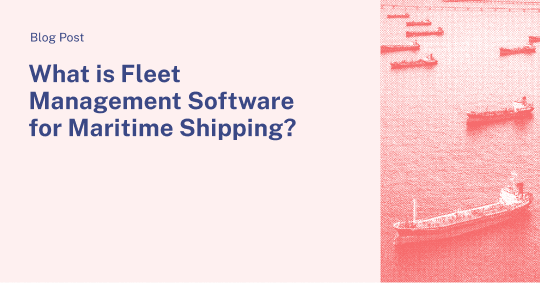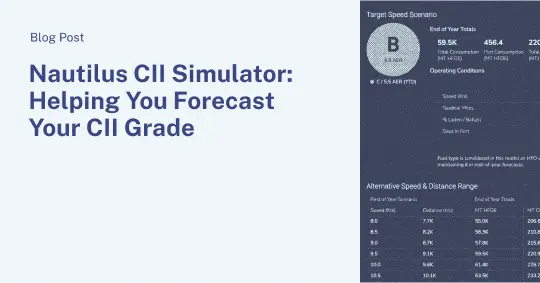The link between crews and shoreside teams – and between shipping owners and charterers – can often hinge on very basic communications. One of these most elemental considerations seems like it should be quite simple, but often times is not: how should the vessel be instructed to operate? What speed makes the most sense given a variety of factors in consideration? Is it possible to provide the crew with an even stronger instruction than speed – such as RPM or power – that accurately takes into account factors like wind, weather, sea-state as well as fuel costs, projected time spent in port, and real-time opportunity costs? How do shoreside teams know if their instruction is the optimal one that will unlock the most daily revenue and profit?
We’ve previously written about how the combination of high frequency data (HFD) with machine learning technology makes vessel performance analysis smarter. But shipping companies should only embrace this technology if it improves the actual economics of their maritime businesses. The reality is that fuel costs are rising as 2020 nears, while new regulations will continue to driving greater requirements for fleet efficiency. Inevitably, the more efficient shipping companies are going to have the competitive advantage and will lead the continuing market consolidation. In this context, one of the best ways to capitalize on technology to improve business economics is through dynamic speed optimization (DSO).
Speed instruction done better
What we see at Nautilus Labs is that most shipping companies still develop their speed instructions using an over-simplified set of assumptions, which in turn leads to suboptimal decision-making. While they may engage with a trusted weather service provider to ensure that they take the safest, most efficient route, the underlying performance expectation for a vessel is limited to a static expected speed/consumption for an entire leg. Leveraging our dynamic machine learning model, however, operators are able to draw upon a dataset that accurately depicts expected performance given any draft or weather condition along an expected route – which ultimately unlocks new profit and revenue opportunities, by generating a voyage speed recommendation that maximizes daily vessel TCE and voyage profit.
Dynamically adjusting vessel performance expectations based on changing draft and weather is just one benefit of our DSO model. Our algorithm also accounts for commercial information such as company-specific budget targets, opportunity cost of re-marketing the vessel, and bunker rates, in order to determine which speed instruction will maximize the financial return on the vessel for the business. While many commercial managers today take similar variables into account when instructing speed, dynamic speed optimization is the equivalent of moving from slide-rule, pen, and paper to a computer dynamically optimizing the instruction in real-time. When combined with our clients’ internal commercial expertise, the net result is competitive advantage in the market that can return tens of thousands of dollars per voyage.
Thousands per voyage, millions per fleet
To demonstrate the accuracy of Nautilus Labs’ DSO model, we conducted an analysis comparing our model’s output relative to an instruction that an actual vessel operated under. On a transatlantic voyage from the US Gulf Coast to the Mediterranean, the ship was instructed to travel at 13 knots, based on a recommendation from a weather service and assistance from an in-house TCE optimization model. Based on this speed recommendation and the associated fuel costs, the voyage would have resulted in a daily TCE of approximately $21,100.
However, Nautilus Labs’ DSO model, with its more accurate prediction of the vessel’s performance in concert with its analysis of market data, identified an opportunity to travel faster (at an optimal speed of 13.9 knots) to get the vessel back into the spot market more quickly at a higher rate. This faster speed increased fuel costs, but also reduced the total days of the voyage by 1.6 days – and ultimately increased the voyage TCE to $21,350.
Thus, dynamic speed optimization produced an optimized speed instruction that would have generated an incremental $250 of TCE per day, totaling $8,225 for in gains for this specific voyage. And this is representative of just one vessel in just one fleet. Extrapolated across hundreds and hundreds of voyages each year, the economic benefit that accrues to our clients is massive. And this is simply the first commercial optimization we are driving with machine learning, soon to encompass RPM/power instruction optimization as a next step – a common request from the Performance and Technical teams we work with.
Maritime digitalization: from “just words” to actual dollars
With all this talk of digitalization in maritime, we hear a lot of the skepticism about technology and its potential impact on shipping businesses. With dynamic speed optimization, we’ve found an optimization that can immediately impact companies’ top and bottom lines. There is a major opportunity for owners, operators, and charterers alike to capture money that is currently being left on the table, because their teams don’t have the data or the tool to effectively capture it. Using our DSO model as a jumping off point, Nautilus Labs is on its way towards unlocking a number of dynamic optimizations like trim, bunker purchasing, pool point allocation, and more.
As a tech company, Nautilus’ goal is to build products that solve problems for our clients in an intuitive and useful way. The Nautilus Labs engineering team is constantly developing, refining, and providing new updates, features and modules for Nautilus Labs’ clients. To see your data in our platform and assess your optimal speed instruction based on our models, please contact us at info@nautiluslabs.com.


